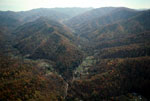Reading the Cultural Landscape
The hills rising away from the Ramp House are rich in family and community history. Names bestowed on every wrinkle in the ridgeline commemorate people, events, and moments in the seasonal round. What appears to be a jumble of coves, ridges, creeks, knobs, branches, gaps, and forks is as legible to some residents as a metropolitan grid is to an urbanite. "These different little hollows," said Howard Miller, "they had a name for each one, so when a neighbor talked to another neighbor about a certain thing that happened at this holler, they knew exactly where it was at, they knew even from Beckley down to Racine down to Madison."
The names for the coves anchor local history and knowledge in the land: Mill Holler, Peach Orchard Holler, School House Holler, and Bee Light Holler, where they baited bees in order to "line" them to wild hives, filled with honey from mixed mesophytic flowering trees like basswood ("lin"), tulip tree ("yellow poplar"), and yellow locust ("mountain locust"). Thus indexed, the landscape is a dynamic repository of rural life, knowledge, and history, which elderly raconteurs render into narrative. "Quill Holler's below the ramp house," Howard went on. "They used to get a hollow straw and drink sugar water where they notched a sugar tree. Something like these straws at a restaurant, but it's a plant."
The cultural landscape is rife with landmarks. Over generations of working the seasonal round, a language for navigating the mountains discriminates them into a wide array of landmarks: not only the highwalls, mine breaks, augur holes, and other traces of industry, but into "knobs," "drains," "coves," "swags," "ridges," "crossings," "gaps," "flats," "bear wallows," "orchards," "homeplaces," "sink holes," "walk paths," "hill climbs," "camp rocks," "bottoms," "brakes," "graveyards," "bee trees," "den trees," and "benches."
This landscape supports the common world celebrated in the Ramp House. Cultural practices like ramp suppers, ramp talk, and roaming the mountains have co-evolved with an industrial landscape16 as ways of holding together a world chronically visited with environmental, social, and economic crisis. Only by bracketing out the civic commons is it possible to reduce a mountain to "a worthless piece of dirt," as one industry spokesman put it, "good for nothing, save for snakes and scrub pine."17 An alternative view--of biodiversity flourishing in the context of community life--is rehearsed in stories and jaunts that map the commons back onto the land.

![]()
![]() Jar of "lin" honey, from Paul Fitzwater, made by bees from the nectar of white basswood. Mary Hufford. 1997/01/21. Library of Congress American Folklife Center.
Jar of "lin" honey, from Paul Fitzwater, made by bees from the nectar of white basswood. Mary Hufford. 1997/01/21. Library of Congress American Folklife Center.

![]()
![]() Blooming tulip poplar (Liriodendron tulipifera) on Rock Creek. Lyntha Scott Eiler. 1996/05/25. Library of Congress American Folklife Center.
Blooming tulip poplar (Liriodendron tulipifera) on Rock Creek. Lyntha Scott Eiler. 1996/05/25. Library of Congress American Folklife Center.

![]()
![]() Aerial view of the confluence of Drews Creek and Peachtree Creek. Lyntha Scott Eiler. 1995/10/26. Library of Congress American Folklife Center.
Aerial view of the confluence of Drews Creek and Peachtree Creek. Lyntha Scott Eiler. 1995/10/26. Library of Congress American Folklife Center.